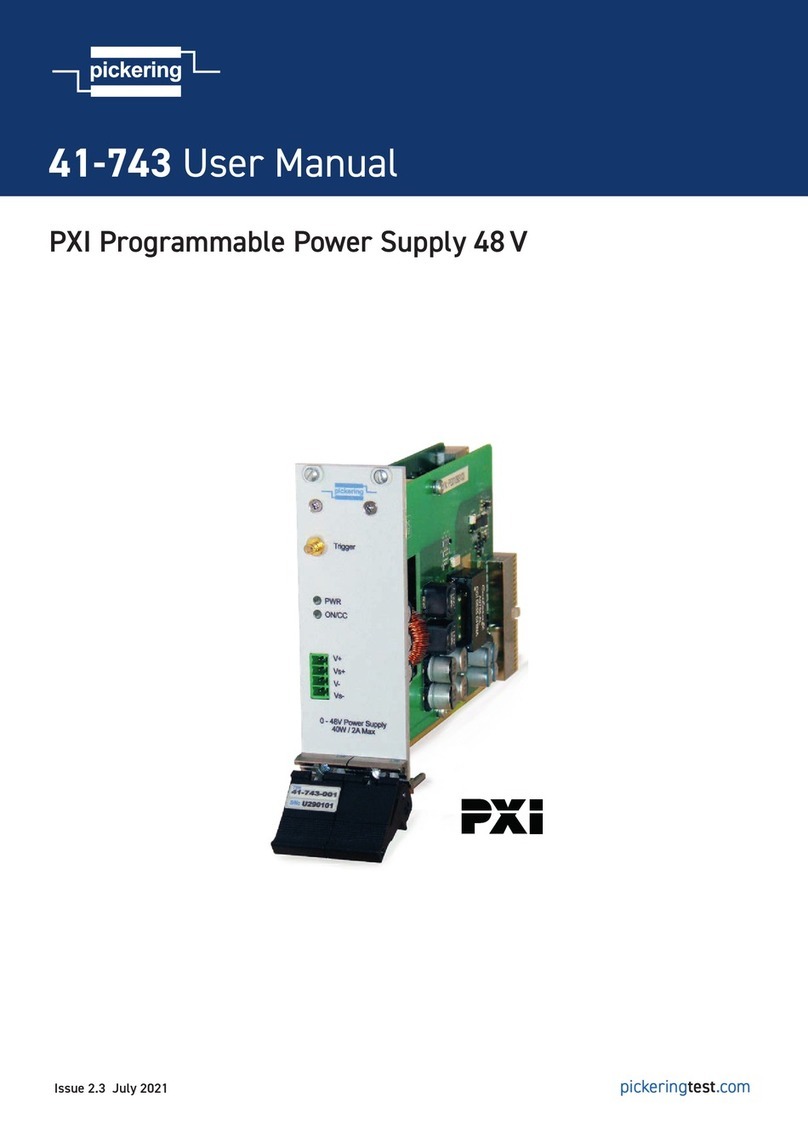
Page 1.1
PXI PROGRAMMABLE POWER SUPPLY MODULE 41-740
pickering SECTION 1 - TECHNICAL SPECIFICATION
SECTION 1 - TECHNICAL SPECIFICATION
Pickering Interfaces’ 41-740 programmable power
supply is designed specifically for test applications that
demand precision output voltage/current and tightly
coupled measurement capabilities.
The versatile design of the 41-740 makes it ideal for
a broad range of testing applications in markets as
diverse as communications, aerospace, and automotive
manufacturing.
Power Levels
41-740
Programmable DC Power Supply
●Dual Isolated Outputs; 0-48VDC/ 2A / 60W
●Current Capability 2A to 30V, 1.25A at 48V
●Programmable Current Limit
●Includes Over Voltage, Over Current and Short
Circuit Protection
●On-Board Isolation and Remote Sense Relays
●16 Bit Read Back of Output Voltage and Current
●Outputs May Be Connected in Parallel or Series
●DLLs & LabVIEW™ Application Software
Input Power
To avoid excess power draw from the PXI backplane,
the 41-740-001 draws input power (+56VDC) via front
panel connections. This approach not only minimizes
power required from the backplane but also maintains
complete isolation between backplane logic and power
conversion circuitry thereby increasing noise immunity.
Pickering Interfaces includes an AC-DC adapter with the
41-740-001 which allows the instrument to be operate
from 90–260VAC mains where +56VDC is not readily
available.
Pickering’s Range of PXI Power Supplies
Model
No. Configuration Channels Input Output
Voltage
Max
Current
41-735 Programmable 2 Backplane
or External 0 to +10V 1A
41-736 Programmable 2 Backplane
or External 0 to -10V 1A
41-740 Programmable 2 56VDC 0 to 48V 2A to 30V,
1.25A at 48V
41-743 Programmable 1 Backplane 0 to 48V 2A to 20V,
0.8A at 48V
41-752 Battery
Simulator 6 Backplane 0 to 7V 300mA Source,
100mA Sink
41-753 Battery
Simulator 1 Backplane 0 to 6V 2.8A Source,
0.5A Sink
The 41-740 programmable power supply
provides two independent and isolated
60W(MAX) supplies, each channel is
programmable from 0-48VDC to a maximum
of 2.0 Amps. The 41-740 includes a
programmable current limit to protect critical
UUTs from excessive current, the output will
automatically switch into constant current
mode when limit is reached. For greater
power or voltage applications, channels can
be connected in series or parallel.
Measurement function
In operation, the capabilities include
quickly setting I/V and then measuring I/V
automatically without processor intervention.
The 41-740 has a hardware built in sequence
list that can execute commands and store
data in a FIFO without processor action.
With the tight integration of a Pickering
Interfaces 41-740, you’ll get high speeds for
high throughput as well as high measurement
accuracy and repeatability for yield integrity.




























